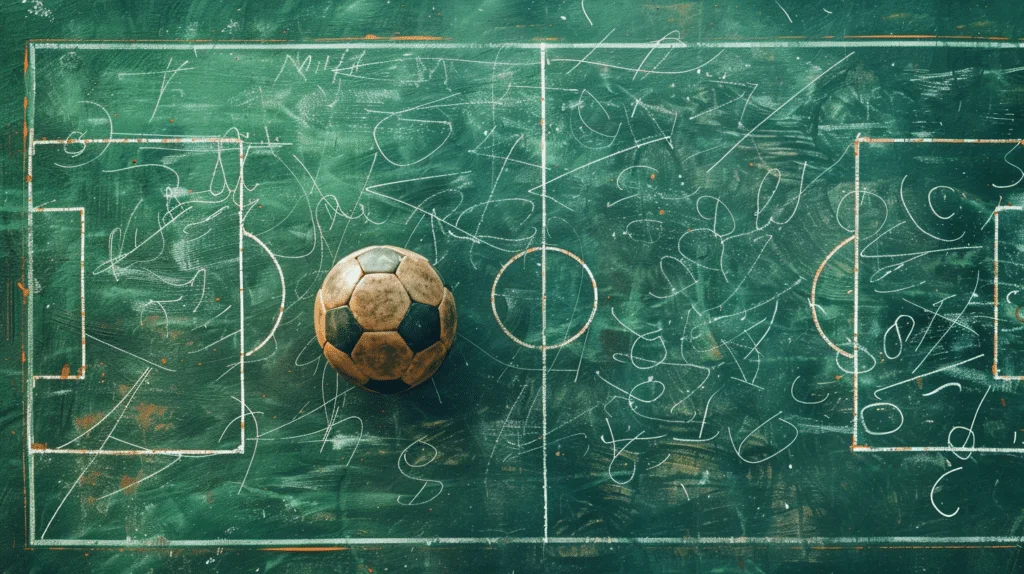The 3-4-3 formation is a tactical system used in football that consists of three defenders, four midfielders, and three forwards. The formation has gained popularity recently due to its attacking nature and ability to create numerical superiority in defense and attack. The 3-4-3 formation had its roots in the 1970s when Dutch football introduced the concept of Total Football, which emphasized fluid positional interchangeability and attacking play.
The basic principles of the 3-4-3 formation revolve around maintaining a solid defensive structure while providing ample attacking options. The three defenders form a central defensive trio, with two wing-backs providing width and support in defense and attack. The four midfielders control the game, provide creativity, and support the defense and attack. The three forwards are the main goal-scoring threats and are tasked with creating chances and putting pressure on the opposition’s defense.
Advantages and disadvantages of the 3-4-3 formation
One of the main advantages of using the 3-4-3 formation is its attacking prowess. With three forwards, more options exist for creating goal-scoring opportunities and putting pressure on the opposition’s defense. The four midfielders provide support and creativity, while the wing-backs offer width and overlapping runs to stretch the opposition’s defense.
Another advantage of the 3-4-3 formation is its ability to create numerical superiority in defense and attack. With three central defenders, there is an extra man to cover defensive duties, making it difficult for the opposition to break through. In attack, the three forwards can overload the opposition’s defense, creating space for other players to exploit.
However, there are also disadvantages to using the 3-4-3 formation. One of the main drawbacks is its vulnerability to counter-attacks. With only three defenders, there is less cover in defense, making it easier for the opposition to exploit spaces left behind. The lack of a dedicated holding midfielder can expose the defense to quick counter-attacks.
Compared to other popular formations, such as the 4-3-3 and 4-2-3-1, the 3-4-3 formation offers a more attacking approach. It provides more options in attack and allows for greater flexibility in positional interchangeability. However, it also requires a high level of tactical discipline and understanding from the players to maintain defensive solidity.
Key positions and roles in the 3-4-3 formation
In the 3-4-3 formation, each position has specific roles and responsibilities.
The three central defenders are responsible for maintaining a solid defensive structure and covering the central areas of the pitch. They need to be strong in aerial duels, have good positioning, and be able to read the game well. They should also be comfortable on the ball and have good passing ability to initiate attacks from the back.
The wing-backs are crucial in providing width and support in both defense and attack. They need good stamina, pace to cover the entire flank, and excellent crossing ability to deliver accurate crosses into the box. They should also be able to track back quickly and provide defensive cover when needed.
The four midfielders are key in controlling the game and providing creativity. The two central midfielders are responsible for dictating play, distributing passes, and breaking up opposition attacks. They need to have good passing ability, vision, and defensive awareness. The wide midfielders provide width and support in attack and tracking back to help in defense.
The three forwards are the main goal-scoring threats in the 3-4-3 formation. The central forward, often called the target man, is responsible for holding up the ball, bringing others into play, and scoring goals. The two wide forwards stretch the opposition’s defense, make runs in behind, and create goal-scoring opportunities.
Defending in the 3-4-3 formation
Defending in the 3-4-3 Formation
Metric
Description
Defensive Line
Depth
The distance between the defensive line and the goal.
Width
The distance between the left and right defenders.
Pressing
The act of putting pressure on the opposing team’s attackers to force them into making mistakes.
Midfield
Tracking Back
The act of midfielders dropping back to help defend when the team is under pressure.
Interceptions
The act of intercepting passes made by the opposing team’s midfielders or attackers.
Wingbacks
Defensive Duties
The responsibilities of the wingbacks in defending the flanks of the pitch.
Overlapping Runs
The act of the wingbacks running past the team’s wingers to create attacking opportunities.
Defending in the 3-4-3 formation requires a well-organized and disciplined approach. The three central defenders must communicate effectively and maintain a compact defensive shape. They should be able to cover each other and anticipate opposition movements.
The wing-backs play a crucial role in both defense and attack. They need to track back quickly and cover the central defenders when defending. They should also be able to press the opposition’s wide players and prevent them from delivering crosses into the box.
In terms of defensive strategies, the 3-4-3 formation can employ a high-pressing approach to win the ball back quickly. The midfielders and forwards can press the opposition’s defense and midfielders, forcing them into making mistakes or playing long balls that can be easily intercepted.
Counter-pressing is another effective defensive tactic in the 3-4-3 formation. After losing possession, the team immediately tries to win it by pressing the opposition players who have just gained possession. This can disrupt the opposition’s rhythm and prevent them from launching quick counter-attacks.
Attacking in the 3-4-3 formation
Attacking in the 3-4-3 formation creates numerical superiority and exploits spaces in the opposition’s defense. The three forwards play a key role by making runs in behind, creating chances, and scoring goals.
The wing-backs provide width and overlapping runs to stretch the opposition’s defense. They should be able to deliver accurate crosses into the box and support the forwards.
The four midfielders are responsible for controlling the game and providing creativity. They should be able to dictate play, distribute passes, and create goal-scoring opportunities. The wide midfielders are crucial in providing width and support in attack and making runs in behind the opposition’s defense.
In terms of offensive strategies, the 3-4-3 formation can employ a possession-based approach, focusing on keeping the ball and creating chances through patient build-up play. The midfielders and forwards can combine quick passing and movement to create openings in the opposition’s defense.
Another offensive strategy is overlapping and underlapping runs to confuse the opposition’s defense. The wing-backs can overlap the wide forwards, creating overloads and providing additional options in attack. The central forward can also make underlapping runs to create space for others to exploit.
Transitioning from defense to attack in the 3-4-3 formation
Quick transitions from defense to attack are crucial in modern football, and the 3-4-3 formation facilitates smooth transitions due to its attacking nature and numerical superiority in defense and attack.
When transitioning from defense to attack, the three central defenders can quickly distribute the ball to the midfielders or wing-backs, who can then initiate attacks with their passing ability and vision. The midfielders and forwards must make quick runs and provide options for the player in possession.
The wing-backs are crucial in transitioning from defense to attack by providing width and support. They should be able to quickly move forward and join the attack, creating overloads and stretching the opposition’s defense.
The midfielders need to quickly transition from defensive duties to supporting the attack. They should have good positional awareness and be able to make runs into the box or provide key passes for the forwards.
Training drills for mastering the 3-4-3 formation
To master the 3-4-3 formation, specific training drills, and exercises can be implemented for each position.
For the central defenders, drills focusing on positioning, communication, and aerial duels can be beneficial. This can include exercises such as small-sided games emphasizing defensive organization and set-piece scenarios.
For the wing-backs, drills focusing on stamina, crossing ability, and defensive positioning can be useful. This can include exercises such as overlapping runs with accurate crosses into the box and one-on-one defensive scenarios.
For the midfielders, drills focusing on passing ability, vision, and defensive awareness can be beneficial. This can include exercises such as possession-based games emphasizing quick passing and movement and defensive scenarios.
For the forwards, drills focusing on goal-scoring ability, movement, and link-up play can be useful. This can include finishing drills, creating chances, and running behind the opposition’s defense.
Teamwork and communication are also crucial in the 3-4-3 formation. Therefore, training drills focusing on these aspects, such as small-sided games emphasizing quick passing and movement, can be beneficial.
Tactical variations of the 3-4-3 formation
The 3-4-3 formation can be tweaked to suit different opponents and situations. One variation is to use a more defensive-minded midfielder instead of one of the wide midfielders. This provides additional defense coverage and allows for a more counter-attacking approach.
Another variation is to use a false nine instead of a traditional central forward. This allows for more fluid positional interchangeability, creating confusion in the opposition’s defense.
Top teams have successfully used variations of the 3-4-3 formation to great effect. For example, Antonio Conte Chelsea used a variation of the 3-4-3 formation to win the Premier League in the 2016-2017 season. Conte employed a more defensive-minded midfielder in the central midfield position, providing additional defense coverage.
Implementing the 3-4-3 formation in youth football
Implementing the 3-4-3 formation in youth football can have several benefits but also comes with challenges.
One of the main benefits is that it encourages attacking play and allows young players to develop their technical skills and creativity. The formation provides ample opportunities for players to express themselves and take risks in the final third.
However, one of the challenges of using the 3-4-3 formation in youth football is that it requires a high level of tactical understanding and discipline from the players. Young players may struggle to maintain defensive shape and positional discipline, leaving the team vulnerable to counter-attacks.
To introduce and teach the 3-4-3 formation to young players, coaches should focus on basic principles such as maintaining defensive shape, providing width and support in attack, and creating numerical superiority. Training drills that emphasize these principles can help young players understand their roles and responsibilities within the formation.
Case studies of successful teams using the 3-4-3 formation
Several top teams have used the 3-4-3 formation effectively in recent years. One notable example is Antonio Conte’s Chelsea, who won the Premier League in the 2016-2017 season using a variation of the formation. Conte Chelsea was known for its solid defensive structure and quick transitions from defense to attack.
Another example is Maurizio Sarris Napoli, who used a more attacking version of the 3-4-3 formation to great effect. Sarri’s Napoli was known for their possession-based style of play and quick passing and movement.
These case studies highlight the effectiveness of the 3-4-3 formation when implemented correctly. They also provide valuable lessons that can be learned and applied to other teams looking to use the formation.
If you are a football enthusiast looking to delve into the intricacies of different formations, you might find this article on the 3-4-3 formation quite intriguing. This tactical setup has gained popularity recently due to its attacking prowess and ability to dominate possession.






